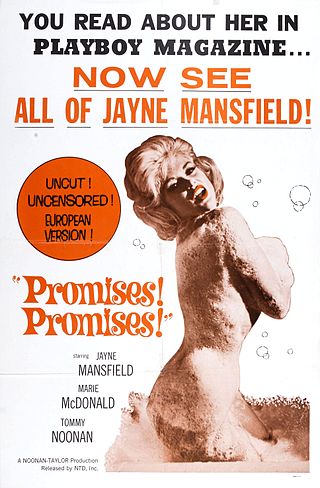Related Research Articles

Hugh Marston Hefner was an American magazine publisher. He was the founder and editor-in-chief of Playboy magazine, a publication with revealing photographs and articles.

Playboy is an American men's lifestyle and entertainment magazine, formerly in print and currently online. It was founded in Chicago in 1953, by Hugh Hefner and his associates, funded in part by a $1,000 loan from Hefner's mother.

The Playboy Mansion, also known as the Playboy Mansion West, is the former home of Playboy magazine founder Hugh Hefner, who lived there from 1971 until his death in 2017. Barbi Benton convinced Hefner to buy the home located in Holmby Hills, Los Angeles, California, near Beverly Hills. From the 1970s onward, the mansion became the location of lavish parties held by Hefner which were often attended by celebrities and socialites. It is currently owned by Daren Metropoulos, the son of billionaire investor Dean Metropoulos, and is used for corporate activities. It also serves as a location for television production, magazine photography, charitable events, and civic functions.

Softcore pornography or softcore porn is commercial still photography, film, or art that has a pornographic or erotic component but is less sexually graphic and intrusive than hardcore pornography, defined by a lack of visual sexual penetration. It typically contains nude or semi-nude actors involved in love scenes and is intended to be sexually arousing and aesthetically beautiful. The distinction between softcore pornography and erotic photography or art, such as Vargas girl pin-ups, is largely a matter of debate.

Dorothy Ruth Hoogstraten, known professionally as Dorothy Stratten, was a Canadian model and actress, primarily known for her appearances as a Playboy Playmate. Stratten was the Playboy Playmate of the Month for August 1979 and Playmate of the Year in 1980, and appeared in three comedy films and in at several episodes of TV shows broadcast on American networks. Dorothy was murdered shortly after co-starring in the movie They All Laughed, at the age of 20, by her estranged husband and manager Paul Snider, whom she was in the process of divorcing and breaking business ties. Snider committed suicide after he killed Stratten.

Star 80 is a 1983 American biographical drama film written and directed by Bob Fosse. It was adapted from the Pulitzer Prize-winning Village Voice article "Death of a Playmate" by Teresa Carpenter and is based on Canadian Playboy model Dorothy Stratten, who was murdered by her husband Paul Snider in 1980. The film's title is taken from one of Snider's vanity license plates. The film was Fosse's final film before his death in 1987.
Arthur Paul was an American graphic designer and the founding art director of Playboy magazine. During his time at Playboy, he commissioned illustrators and artists, including Andy Warhol, Salvador Dalí, and James Rosenquist, as part of the illustration liberation movement.

The Playboy Club was initially a chain of nightclubs and resorts owned and operated by Playboy Enterprises. The first Playboy Club opened in Chicago in 1960. Each club generally featured a Living Room, a Playmate Bar, a Dining Room, and a Club Room. Members and their guests were served food and drinks by Playboy Bunnies, some of whom were featured in Playboy magazine. The clubs offered name entertainers and comedians in the Club Rooms, and local musicians and the occasional close-up magician in the Living Rooms. Starting with the London and Jamaica club locations, the Playboy Club became international in scope.
Connie Mason is an American model and actress who was Playboy magazine's Playmate of the Month for its June 1963 issue. Mason then acted in the gore movies pioneered by Herschell Gordon Lewis, Blood Feast and Two Thousand Maniacs! Her centerfold was photographed by Pompeo Posar. She was also a Playboy Bunny at the Chicago club.
Victor Aubrey Lownes III was an executive for HMH Publishing Company Inc., later known as Playboy Enterprises, from 1955 through the early 1980s. Soon after he met Hugh Hefner in 1954, Hefner founded Playboy magazine, and Lownes eventually joined his publishing company, serving as vice president. Lownes was a close confidant of Hefner and gained a reputation for dating Playboy Playmates.
Sondra Theodore is an American model and actress. She was Playboy magazine's Playmate of the Month for its July 1977 issue. Her centerfold was photographed by Ken Marcus. Her Playmate pictorial was the first to include the Data Sheets that Playmates had been filling out since 1959.

Promises! Promises! is a 1963 American sex comedy film directed by King Donovan and starring Tommy Noonan and Jayne Mansfield. Released at the end of the Production Code era and before the MPAA film rating system became effective in 1968, it was the first Hollywood film of the sound era to feature nudity by a mainstream star (Mansfield).

Miss March is a 2009 American sex comedy film written, starring, and directed by Trevor Moore and Zach Cregger, stars of the IFC show The Whitest Kids U' Know. The film was released on March 13, 2009. It marks the final on-screen film appearance of Hugh Hefner before his death in 2017. It is also the first of only three films directed by Trevor Moore before his death in 2021, the second being "The Civil War On Drugs" which was aired in segments in the final season of The Whitest Kids U' Know in 2011, and the third being the animated comedy “Mars” which is set to be released posthumously.
Michael Trikilis was an American film and television producer, known mostly for his involvement with Playboy TV. In 1981, Trikilis, along with Hugh Hefner, developed much of the original programming for "The Playboy Channel". Most notably, Trikilis developed the signature "Playboy style" of video, which features women, Playboy Playmates and Celebrity Centerfolds, often in dreamlike versions of their everyday lives. He has appeared as himself on E!'s reality show The Girls Next Door.
The 26th Canadian Film Awards were held on October 12, 1975 to honour achievements in Canadian film. The ceremony was hosted by radio personality Peter Gzowski.
Brigitte Berman is a Canadian documentary filmmaker, most noted for her 1985 film Artie Shaw: Time Is All You've Got.
References
- ↑ Ebert, Roger (6 August 1967). "Hugh Hefner: Just a typical Methodist kid". rogerebert.com. Retrieved 26 June 2022.
- 1 2 Sheppard, Gordon. "The Making of Eliza's Horoscope". Archived from the original on 7 October 2020. Retrieved 26 June 2022.
- ↑ Morris, Peter (1984). The Film Companion . Toronto: Irwin Publishing. pp. 270–271. ISBN 0-7725-1505-0.
- ↑ Pratley, Gerald (1987). Torn Sprockets: The Uncertain Projection of the Canadian Film. Cranbury, NJ: Associated University Presses. p. 223. ISBN 0874131944.
- ↑ "Best-film showdown: 11 vie for all-Canadian honours". Ottawa Journal . October 3, 1975. p. 39. Retrieved March 28, 2018– via Newspapers.com.
